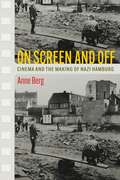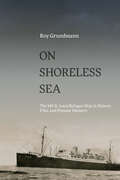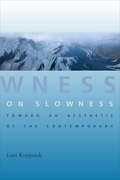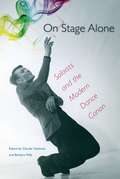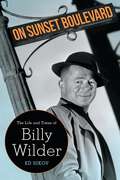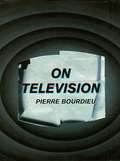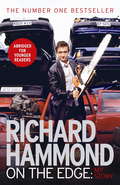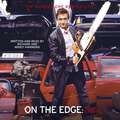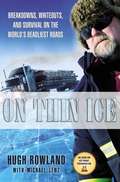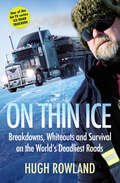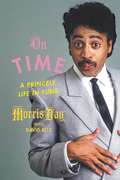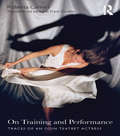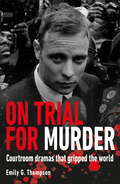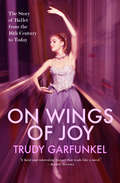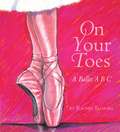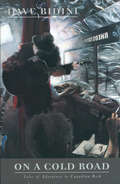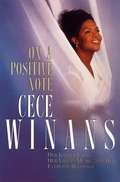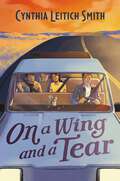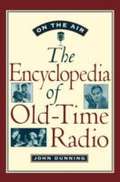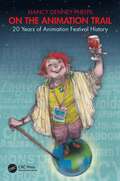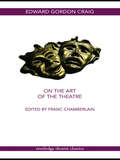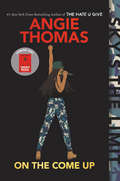- Table View
- List View
On Screen and Off: Cinema and the Making of Nazi Hamburg
by Anne BergOn Screen and Off shows that the making of Nazism was a local affair and the Nazi city a product of more than models and plans emanating from Berlin. In Hamburg, film was key in turning this self-styled "Gateway to the World" into a "Nazi city." The Nazi regime imagined film as a powerful tool to shape National Socialist subjects. In Hamburg, those very subjects chanced upon film culture as a seemingly apolitical opportunity to articulate their own ideas about how Nazism ought to work. Tracing discourses around film production and film consumption in the city, On Screen and Off illustrates how Nazi ideology was envisaged, imagined, experienced, and occasionally even fought over.Local authorities in Hamburg, from the governor Karl Kaufmann to youth wardens and members of the Hamburg Film Club, used debates over cinema to define the reach and practice of National Socialism in the city. Film thus engendered a political space in which local activists, welfare workers, cultural experts, and administrators asserted their views about the current state of affairs, articulated criticism and praise, performed their commitment to the regime, and policed the boundaries of the Volksgemeinschaft. Of all the championed "people's products," film alone extended the promise of economic prosperity and cultural preeminence into the war years and beyond the city's destruction. From the ascension of the Nazi regime through the smoldering rubble, going to the movies grounded normalcy in the midst of rupture.
On Shoreless Sea: The MS St. Louis Refugee Ship in History, Film, and Popular Memory (SUNY series, Horizons of Cinema)
by Roy GrundmannCombines new archival research with innovative theory to reassess the ship's dramatic voyage and analyze its representation in a broad range of texts, films, and artifacts of popular memory.In 1939, the ocean liner MS St. Louis undertook a dramatic voyage with over nine hundred Jewish refugees that caught the world's attention and has been remembered in numerous printed texts, films, and artifacts. Denied permission to dock in Cuba, the United States, and Canada, the ship was finally forced to return to Europe, where many of teh refugees ultimately perished in the Holocaust. On Shoreless Sea is the first work to comprehensively analyze the journey's unfolding, its historical context, and its key representations in various media. Based on new archival research and featuring a translation of Captain Gustav Schröder's account of the voyage, the book corrects long-standing misassumptions about its subject. Author Roy Grundmann illuminates the voyage's historical significance and demonstrates its relevance to our present, in which prosperous nations once again stem mass migration. Arguing that the Jewish refugee crisis was caused not only by anti-Semitism but also by colonialism and neocolonialism, Grundmann calls for Holocaust studies to expand its field of inquiry and methodology. Working at the intersection of Holocaust studies, postcolonial theory, film and media studies, and cultural studies, On Shoreless Sea reads St. Louis memory culture as a reservoir of contradictory attitudes toward migration whose texts both intentionally and inadvertently testify to the need to discuss the Holocaust in relation to other genocides without denying its uniqueness.
On Slowness
by Lutz KoepnickA counterintuitive take on the deceleration of time and its function in contemporary art and culture.
On Slowness: Toward an Aesthetic of the Contemporary (Columbia Themes in Philosophy, Social Criticism, and the Arts)
by Lutz KoepnickSpeed is an obvious facet of contemporary society, whereas slowness has often been dismissed as conservative and antimodern. Challenging a long tradition of thought, Lutz Koepnick instead proposes we understand slowness as a strategy of the contemporary—a decidedly modern practice that gazes firmly at and into the present's velocity.As he engages with late twentieth- and early twenty-first-century art, photography, video, film, and literature, Koepnick explores slowness as a critical medium to intensify our temporal and spatial experiences. Slowness helps us register the multiple layers of time, history, and motion that constitute our present. It offers a timely (and untimely) mode of aesthetic perception and representation that emphasizes the openness of the future and undermines any conception of the present as a mere replay of the past. Discussing the photography and art of Janet Cardiff, Olafur Eliasson, Hiroshi Sugimoto, and Michael Wesely; the films of Peter Weir and Tom Tykwer; the video installations of Douglas Gordon, Willie Doherty, and Bill Viola; and the fiction of Don DeLillo, Koepnick shows how slowness can carve out spaces within processes of acceleration that allow us to reflect on alternate temporalities and durations.
On Stage & In Shadows: a career memoir
by Marie Wallace"Broadway veteran Marie Wallace provides an intimate. informative, often humorous look behind the scenes of some stage classics. And her Dark Shadows fans will learn fun new facts about the Gothic soap opera."
On Stage Alone: Soloists and the Modern Dance Canon
by Claudia Gitelman Barbara PalfySoloists ignited the modern dance movement and have been a source of its constant renewal. Pioneering dancers such as Loïe Fuller, Isadora Duncan, Ruth St. Denis, and Maud Allan embodied the abstraction and individuality of the larger modernist movement while making astounding contributions to their art. Nevertheless, solo dancers have received far less attention in the literature than have performers and choreographers associated with large companies.In On Stage Alone, editors Claudia Gitelman and Barbara Palfy take an international approach to the solo dance performance. The essays in this standout volume broaden the dance canon by bringing to light modern dance soloists from Europe, Asia, and the Americas who have shaped significant, sustained careers by performing full programs of their own choreography.Featuring in-depth examinations of the work of artists such as Michio Ito, Daniel Nagrin, Ann Carlson, and many others, On Stage Alone reveals the many contributions made by daring solo dancers from the dawn of the twentieth century through today. In doing so, it explores many important statements these soloists made regarding topics such as freedom, personal space, individuality, and gender in the modern era.
On Sunset Boulevard: The Life and Times of Billy Wilder
by Ed SikovOn Sunset Boulevard, originally published in 1998, describes the life of acclaimed filmmaker Billy Wilder (1906-2002), director of such classics as Sunset Boulevard, The Lost Weekend, The Seven Year Itch, and Sabrina. This definitive biography takes the reader on a fast-paced journey from Billy Wilder's birth outside of Krakow in 1906 to Vienna, where he grew up, to Berlin, where he moved as a young man while establishing himself as a journalist and screenwriter, and triumphantly to Hollywood, where he became as successful a director as there ever was.Double Indemnity, Sunset Boulevard, Some Like It Hot, and The Apartment"Wilder's cinematic legacy is unparalleled. Not only did he direct these classics and twenty-one other films, he co-wrote all of his own screenplays. Volatile, cynical, hilarious, and driven, Wilder arrived in Hollywood an all-but-penniless refugee who spoke no English. Ten years later he was calling his own shots, and he stayed on top of the game for the next three decades. Wilder battled with Humphrey Bogart, Marilyn Monroe, Bing Crosby, and Peter Sellers; kept close friendships with William Holden, Audrey Hepburn, Jack Lemmon, and Walter Matthau; amassed a personal fortune by way of blockbuster films and shrewd investments in art (including Picassos, Klees, and Mir's); and won Oscars--yet Wilder, ever conscious of his thick accent, always felt the sting of being an outsider.On Sunset Boulevard traces the course of a turbulent but fabulous life, both behind the scenes and on the scene, from Viennese cafes and Berlin dance halls in the twenties to the Hollywood soundstages of the forties and the on-location shoots of the fifties and sixties. Crammed with Wilder's own caustic wit, On Sunset Boulevard reels out the story of one of cinema's most brilliant and prolific talents.
On Television
by Pierre BourdieuBourdieu had long been concerned with the role of television in cultural and political life when he bypassed the political and commercial control of the television networks and addressed his country's viewers from the television station of the College de France. "On Television," which expands on that lecture, not only describes the limiting and distorting effect of television on journalism and the world of ideas, but offers the blueprint for a counterattack.
On The Edge: My Story
by Richard HammondGripping account by Richard Hammond of life before and after his terrifying high-speed car crash.Richard Hammond is one of our most in-demand and best-loved television presenters. In September 2006, he suffered a serious brain injury following a high-speed car crash. ON THE EDGE is his compelling account of life before and after the accident and an honest description of his recovery, full of drama and incident. An adrenalin junkie long before his association with Top Gear, Richard tells the story of his life, from the small boy showing off with ridiculous stunts on his bicycle to the adolescent with a near-obsessive attraction to speed and the smell of petrol.After a series of jobs in local radio, he graduated to television and eventually to Top Gear. His insights into the personalities, the camaraderie and the stunts for which Top Gear has become famous, make compulsive reading. It was whilst filming for Top Gear that Richard was involved in a high speed crash, driving a jet-powered dragster. His wife Mindy tells the story of the anxious hours and days of watching and waiting until he finally emerged from his coma. In an extraordinarily powerful piece of writing, she and Richard then piece together the stages of his recovery as his shattered mind slowly reformed. The final chapter recounts his return home and his triumphant reappearance in front of the cameras.
On The Edge: My Story
by Richard HammondGripping account by Richard Hammond of life before and after his terrifying high-speed car crash.Richard Hammond is one of our most in-demand and best-loved television presenters. In September 2006, he suffered a serious brain injury following a high-speed car crash. ON THE EDGE is his compelling account of life before and after the accident and an honest description of his recovery, full of drama and incident. An adrenalin junkie long before his association with Top Gear, Richard tells the story of his life, from the small boy showing off with ridiculous stunts on his bicycle to the adolescent with a near-obsessive attraction to speed and the smell of petrol.After a series of jobs in local radio, he graduated to television and eventually to Top Gear. His insights into the personalities, the camaraderie and the stunts for which Top Gear has become famous, make compulsive reading. It was whilst filming for Top Gear that Richard was involved in a high speed crash, driving a jet-powered dragster. His wife Mindy tells the story of the anxious hours and days of watching and waiting until he finally emerged from his coma. In an extraordinarily powerful piece of writing, she and Richard then piece together the stages of his recovery as his shattered mind slowly reformed. The final chapter recounts his return home and his triumphant reappearance in front of the cameras.
On The Edge: My Story
by Richard HammondAn adrenalin junkie long before his association with Top Gear, Richard tells the story of his life, from the small boy showing off with ridiculous stunts on his bicycle to the adolescent with a near-obsessive attraction to speed and the smell of petrol.After a series of jobs in local radio, he graduated to television and eventually to Top Gear. His insights into the personalities, the camaraderie and the stunts for which Top Gear has become famous, make compulsive reading.It was whilst filming for Top Gear that Richard was involved in a high speed crash, driving a jet-powered dragster. His wife Mindy tells the story of the anxious hours and days of watching and waiting until he finally emerged from his coma. In an extraordinarily powerful piece of writing, she and Richard then piece together the stages of his recovery as his shattered mind slowly reformed.Read by Richard and Mindy Hammond(p) 2007 Orion Publishing Group
On Thin Ice: Breakdowns, Whiteouts, and Survival on the World's Deadliest Roads
by Michael Lent Hugh RowlandYou've watched him battle the odds on History's Ice Road Truckers. Now read Hugh "The Polar Bear" Roland's own storm-by-storm account of surviving and conquering the infamous ice roads of the Arctic. Join Hugh in the front seat of his truck as he shares his most chilling, adrenaline-fueled tales of the world's most dangerous job. Every year, a fleet of truckers travels beyond the northern equatorial line to the Arctic Circle, battling subzero temperatures and perilous conditions. Though treacherous, it is a region heavily endowed with natural resources. Locating this abundance of natural gas, conflict-free diamonds, and gold is relatively easy; extracting and transporting these goods is another matter entirely. The elite truckers chosen to deliver materials vital to these efforts spend two months traveling distances greater than Western Europe on naturally formed roads of ice that is only sixteen inches thick. It is one of the most dangerous jobs in the world. For more than twenty years, Hugh Rowland has survived the ice roads like none other. Each year when the temperature plummets, Rowland leaves his family in Vancouver, Canada, to drive 1,900 miles to Yellowknife, where he will begin his odyssey. Facing the threat of perilous avalanches, hundred-foot cliffs, and the ever-present danger of cracking through the ice, Hugh must push himself to the limit. The payoff is sweet, but Rowland isn't in it just for the money; he is driven by the camaraderie, the call to adventure, and the chance to battle the odds year after year. From the first snowstorm to the final thaw, On Thin Ice traces the history of ice road trucking, chronicles Rowland's preparation for the trek, and follows him through his perilous journey along the infamous ice roads. Take a ride with Rowland as he recounts tales of epic breakdowns and breathtaking heroism that are just a daily part of the job. In this classic battle of man and machine versus cruelest nature, only the strong will survive to see their payday, their families, and the chance to do it all over again . . . on thin ice. WHEN HELL FREEZES OVER . . . "You've never experienced winter until you've lived through one in the far north. It starts in October and doesn't let up until mid-April. The temperatures drop to minus 70, with winds blowing 60 miles an hour. At that temperature, you throw a pot of boiling water or coffee into the air and it will instantly vaporize and turn into snow. It's cold as hell, but it's also full of riches: silver, gold, uranium, diamonds, and oil worth tens of billions of dollars. Locating these treasures in the frozen tundra is the easy part. Getting them out of the ground and bringing them from the frozen wasteland to civilization is a lot tougher. That's my job." --From Ice Road Truckers
On Thin Ice: Breakdowns, Whiteouts, and Survival on the World's Deadliest Roads
by Hugh RowlandFrom floating ice to snowstorms - meet the adrenalin junkie and death-defying star of the History Channel and Five USA's hit show ICE ROAD TRUCKERS.Every year a fleet of men travel to the Arctic Circle, a region heavily endowed with natural resources. Locating the abundance of natural gas, conflict-free diamonds and gold is relatively easy - but extracting and transporting these goods is another matter entirely. The truckers picked to deliver these precious commodities spend two months traveling hundreds of miles on a naturally formed road of ice. It is one of the most dangerous jobs in the world.For more than 20 years, Hugh Rowland has survived the ice roads like no other. Known by the ice road trucking community as 'The Polar Bear' - a reference to his legendary stamina, strong personality, bearish attitude and prowess on the ice - Rowland has performed amazing feats and survived spectacular wrecks to become the undisputed king of the ice road truckers. Each year when the temperature plummets to -70°C, Rowland leaves his family, home and successful excavation business north of Vancouver, Canada, to drive 1900 miles to Yellowknife, where he throttles up for another ice road season. ON THIN ICE traces the history of ice road trucking, the preparation for the trek and follows Rowland through his nine week journey across the infamous Ice Road. From the first snowstorm to the final thaw, this adrenalin-filled book follows his journey to the edge of endurance and back. It's an extraordinary look at an extreme life.
On Time: A Princely Life in Funk
by Morris DayA memoir by Morris Day of The Time centering around his lifelong relationship and association with Prince.Brilliant composer, smooth soul singer, killer drummer, and charismatic band leader, Morris Day, has been a force in American music for the past four decades. In On Time, the renowned funkster looks back on a life of turbulence and triumph. He chronicles his creative process with an explosive prose that mirrors his intoxicating music. Morris' story is a fast-paced page-turner replete with unexpected twists and shocking surprises. A major and fascinating theme is his lifelong friendship and years of musical partnership with Prince, from their early days on the Minneapolis scene to selling out stadiums and duking it out as rivals in Purple Rain. Eventually, Morris went on to release four albums with a new band of his very own, the legendary Time. He battled his addictions and came out victorious. But not before increasing tensions and embittered rivalry between Prince and the Revolution and Morris Day and the Time led the two performers towards separate paths. Through the years, the fierce brotherly love between Morris and Prince kept bringing them back together, over and over again-until pride, ego, and circumstance interfered. Two months before Prince's untimely death, the two finally reconnected and started to make amends. But Morris could've never imagined it would be the last time he'd ever see his friend again. This is Morris Day's singular story in which the magic of music is the ultimate healer. On Time is also a deep meditation on friendship, Morris' poetic method of reconciling the loss of his close friend and longtime collaborator, and a way to commemorate an incendiary life cut short. But this book is more than just a walk down memory lane-it's a metaphorical means to bring Prince back to life. Throughout the narrative, Morris allows Prince's "voice" to protect his own legacy, to counter Morris's interpretations of events, and to essentially breathe new life into a tale as old as time-of two brothers, two bands, and a musical culture that even today pulsates with fresh energy.
On Training and Performance: Traces of an Odin Teatret Actress
by Roberta Carreri"Outstanding … a technical manual (for actors and directors), an historical document of importance, and a volume that is a delight to read." Ian Watson, Rutgers "An extremely valuable personal account of Roberta Carreri’s process as an actor." Alison Hodge, Artistic Director, The Quick and the Dead "An excellent book with a unique voice." Ben Spatz, University of Huddersfield Roberta Carreri is one of acclaimed theatre company Odin Teatret's longest-serving actors, and the last to be trained by Eugenio Barba himself. In this book, she relives the milestones of her professional journey, including: her first experiences of street theatre the discovery of Asian performance traditions pedagogical activities and character creation encounters with artists and spectators the inception of her solo performances, Judith and Salt Interwoven with rich photographic documentation and a wealth of biographical information, this inspiring handbook reveals the professional secrets of an Odin Teatret actor as well as the story of a life of work, research, and passion.
On Trial For Murder
by DKUncover the dramatic events surrounding some of the world's most controversial murder trials.Explore the riveting twists and turns of some of the most notorious and controversial murder trials in history, such as the O. J. Simpson, Phil Spector and Oscar Pistorius cases. From arrests to vital evidence, trials to final verdicts – no stone is left unturned in these chilling and complete accounts of the cases that shocked the world.The latest in a series of True Crime volumes that includes:MORE THAN 10 FAMOUS CASES: Trials include those of Lizzie Borden, O.J. Simpson, Phil Spector, Ruth Ellis, Oscar Pistorius and Derek ChauvinFULL-COLOUR IMAGES: 16 pages packed with photos that give additional context to each trialALL THE KEY EVIDENCE: Pore over the clues and facts as presented in court as you retread each case, step by stepThe stakes are never higher when the charge is murder… Each of the trials detailed in this book dominated the world's news media and gripped public attention. After examining the evidence, if you had been a member of the jury, what would have been your verdict? Guilty? Or Not Guilty?Perfect for adult fans of true crime books, podcasts, TV documentaries and films, On Trial for Murder follows in the footsteps of these previous true crime titles:Killers Caught: True Stories of Extraordinary Murder HuntsUnsolved Murders: True Crime Cases UncoveredCults Uncovered: True Stories of Mind Control and MurderMysteries Uncovered: True Stories of the Paranormal and UnexplainedBehind the Horror: True Stories That Inspired Horror MoviesConspiracies Uncovered: Cover-ups, Hoaxes, and Secret Societies
On Wings of Joy: The Story of Ballet from the 16th Century to Today
by Trudy Garfunkel&“A lucid and interesting history&” of ballet—from sixteenth-century French Royalty to contemporary masters—&“that reads like a novel&” (Kirkus Reviews). In this engaging history of dance, readers are introduced to the major performers, choreographers, and composers who influenced the development of ballet. Beginning with the birth of the art in the sixteenth-century French court of Catherine d&’ Medici, this informative text traces ballet as it evolved in Europe and Russia, and subsequently in England and then the United States. Included are details about the creation of such classics as Giselle, Swan Lake, The Sleeping Beauty, and Serenade, as well as the contributions of such prominent figures as Pavlova, Nijinsky, Balanchine, and Ashton. Fascinating facts include inside looks at contemporary ballet companies, how toe shoes are made, and what a professional dancer&’s day is like. All in all, a delightful, enjoyable, and informative historical overview that will delight anyone who enjoys the art of dance.
On Your Toes: A Ballet ABC
by Rachel IsadoraA former professional ballerina and Caldecott Honor artist presents this ABC book that gives young readers an inside look at the ballet while explaining terms and positions using the alphabet.
On a Cold Road
by Dave BidiniDavid Bidini, rhythm guitarist with the Rheostatics, knows all too well what the life of a rock band in Canada involves: storied arenas one tour and bars wallpapered with photos of forgotten bands the next. Zit-speckled fans begging for a guitar pick and angry drunks chucking twenty-sixers and pint glasses. Opulent tour buses riding through apocalyptic snowstorms and cramped vans that reek of dope and beer. Brilliant performances and heart-sinking break-ups.Bidini has played all across the country many times, in venues as far flung and unalike as Maple Leaf Gardens in Toronto and the Royal Albert Hotel in Winnipeg. In 1996, when the Rheostatics opened for the Tragically Hip on their Trouble at the Henhouse tour, Bidini kept a diary. In On a Cold Road he weaves his colourful tales about that tour with revealing and hilarious anecdotes from the pioneers of Canadian rock - including BTO, Goddo, the Stampeders, Max Webster, Crowbar, the Guess Who, Triumph, Trooper, Bruce Cockburn, Gale Garnett, and Tommy Chong - whom Bidini later interviewed in an effort to compare their experiences with his. The result is an original, vivid, and unforgettable picture of what it has meant, for the last forty years, to be a rock musician in Canada.From the Trade Paperback edition.
On a Positive Note: Her Joyous Faith, Her Life in Music, and Her Everyday Blessings
by Renita Weems Cece WinansFrom a childhood of humble beginnings to her current status as one of the most sought-after performers in Christian music, CeCe Winans tells her uplifting story. Forthright and honest, CeCe takes the reader into her life, detailing a career that began in the early 1980's and continues to the present. Once a shy girl who preferred the church choir loft to the spotlight, this talented and vivacious woman details the journey of her musical career and the faith that has guided her every step of the way.
On a Wing and a Tear
by Cynthia L SmithA living legend roosting in the backyard. An unmissable game. A hair-raising mystery. A road trip full of adventure and danger. And all the overlapping circles that connect us throughout Creation.Melanie “Mel” Roberts and Ray Halfmoon may be from different Indigenous Nations, but the friends have become like siblings since the Robertses moved in with the Halfmoons. And they soon welcome a distinguished guest: Great-grandfather Bat, whose wing is injured, has taken refuge in their old oak tree.A rematch of the legendary Great Ball Game is coming up, with Bat as the star player. Grampa Charlie Halfmoon offers to drive Bat from Chicago down to the traditional playing field outside Macon, Georgia, and Mel and Ray are determined to help out.Together, they all set off on a road trip—facing adventure, danger, and a hair-raising mystery—on the way to the historic game.With loving care and boisterous humor, acclaimed author Cynthia Leitich Smith (Muscogee) tells a modern folklore story about friendship, embracing the unexpected, and all the overlapping circles that connect us throughout Creation. Perfect for fans of Kate DiCamillo, Brian Young, and Elana K. Arnold!
On the Air: The Encyclopedia of Old-Time Radio
by John DunningNow long out of print, John Dunning's Tune in Yesterday was the definitive one-volume reference on old-time radio broadcasting. Now, in On the Air, Dunning has completely rethought this classic work, reorganizing the material and doubling its coverage to provide a richer and more informative account of radio's golden age. Here are some 1,500 radio shows presented in alphabetical order. The great programs of the '30s, '40s, and '50s are all here--Amos & Andy, Fibber Me Gee and Molly, The Lone Ranger, Major Bowes' Original Amateur Hour, and The March of Time, to name only a few. For each, Dunning provides a complete broadcast history, with the time- slot, the network, and the name of the show's sponsors. He lists major cast members, announcers, producers, directors, writers, and sound effects people-even the show's theme song. There are also umbrella entries, such as "News Broadcasts," which features an engaging essay on radio news, with capsule biographies of major broadcasters like Lowell Thomas and Edward R. Murrow. Equally important, Dunning provides a fascinating account of each program, taking us behind the scenes to capture the feel of the performance, such as the ghastly sounds of Lights Out (a horror drama where heads rolled and bones crunched), and providing engrossing biographies of the main people involved in the show. A wonderful read for everyone who loves old-time radio, On the Air is a must purchase for all radio hobbyists and anyone interested in 20th-century American history. It is an essential reference work for libraries and radio stations. JOHN DUNNING is a popular mystery novelist, author of The Bookman's Wake and Booked to Die. He lives in Aurora, Colorado.
On the Animation Trail: 20 Years of Animation Festival History
by Nancy Denney-PhelpsThis book charts the history of more than 20 years of animation festivals. From Annecy, the oldest animation festival in the world, to Beirut, or the founding of the festival in Peja, Kosovo, Nancy Denney‑Phelps has recorded not just the films screened but also the people and what makes each festival unique.What is it like to travel to China, Beirut, or Kosovo for an animation festival? Spend a week on a boat with 200 animators from around the world or be thrown off a train in Belarus? All of this and much, much more has happened to Nancy Denney‑Phelps in her many years as an animation journalist.Documenting more than 20 years of travels, this book will appeal to all those with an interest in animation. If you are a young animator and want to know what festival life is like, this is the book for you. If you are a seasoned veteran and want to bring back some memories of festivals past, this book should bring some smiles to your face.
On the Art of the Theatre
by Edward Gordon CraigFirst published in 1911, On the Art of the Theatre remains one of the seminal texts of theatre theory and practice. Actor, director, designer and pioneering theorist, Edward Gordon Craig was one of twentieth century theatre’s great modernisers. Here, he is eloquent and entertaining in expounding his views on the theatre; a crucial and prescient contribution that retains its relevance almost a century later. This reissue contains a wealth of new features: a specially written Introduction and notes from editor Franc Chamberlain an updated bibliography further reading. Controversial and original, On the Art of the Theatre stands as one of the most influential books on theatre of the twentieth century.
On the Come Up
by Angie ThomasSixteen-year-old Bri wants to be one of the greatest rappers of all time. Or at least win her first battle. As the daughter of an underground hip hop legend who died right before he hit big, Bri’s got massive shoes to fill. <p><p> But it’s hard to get your come up when you’re labeled a hoodlum at school, and your fridge at home is empty after your mom loses her job. So Bri pours her anger and frustration into her first song, which goes viral…for all the wrong reasons. <p> Bri soon finds herself at the center of a controversy, portrayed by the media as more menace than MC. But with an eviction notice staring her family down, Bri doesn’t just want to make it—she has to. Even if it means becoming the very thing the public has made her out to be. <p> Insightful, unflinching, and full of heart, On the Come Up is an ode to hip hop from one of the most influential literary voices of a generation. It is the story of fighting for your dreams, even as the odds are stacked against you; and about how, especially for young black people, freedom of speech isn’t always free. <P><b>A New York Times Bestseller</b>
